First Steps
This section provides a simple, easy-to-understand example of creating a network hierarchy and IP pools for new or existing deployments. It helps familiarize users with Catalyst Center as Code to manage Catalyst Center.
The repository used in this example can be found at: https://github.com/netascode/nac-catalystcenter-simple-example
This example assumes you have installed the following prerequisites.
- Terraform 1.8.0 or later.
- Git
- Your preferred text editor / Integrated Development Environment (IDE) (such as VisualStudio Code)
Getting Started
Section titled “Getting Started”Start by cloning the repository to your local system:
git clone https://github.com/netascode/nac-catalystcenter-simple-example.gitOpen the folder in your preferred editor / IDE.
The working area should look like this (the editor shown here is vsCode):

The main.tf file contains the required providers, provider settings and points to the location of all *.yaml file definitions.
module "catalyst_center" { source = "netascode/nac-catalystcenter/catalystcenter" version = "0.1.1"
yaml_directories = ["data/"]}Sites definitions
Section titled “Sites definitions”An example site’s definition is provided in data/sites.nac.yaml. This is where the data (variable definition) is abstracted from the logic (infrastructure declaration).
Before diving into this file, it is worth understanding the *.yaml files and their structure in the data folder a bit better. As different teams might be responsible for different parts of the infrastructure, these definitions need to be flexible. Some organizations might want to use a single *.yaml file for their entire network hierarchy, while others prefer a *.yaml file per area. The names of the yaml files are completely arbitrary. These two examples are explained below:
- Example 1: Group multiple areas in the same
*.yamlfile
multiple_areas.nac.yaml
catalyst_center: sites: areas: - name: Canada parent_name: Global - name: Poland parent_name: Global- Example 2: Split the configuration for areas into multiple
*.yamlfiles
emear_areas.nac.yaml
---catalyst_center: sites: areas: - name: Poland parent_name: Globalamer_areas.nac.yaml
---catalyst_center: sites: areas: - name: Canada parent_name: GlobalNow that you are familiar with the structure, it is time to get into the example.
Step 1: Sites Validation
Section titled “Step 1: Sites Validation”This is where the exciting bit starts. Navigate to data/sites.yaml and take note of the structure. This example contains five areas, four buildings and six floors.
sites.nac.yaml
---catalyst_center: sites: areas: - name: United States parent_name: Global - name: Golden Hills Campus parent_name: Global/United States - name: Lakefront Tower parent_name: Global/United States - name: Oceanfront Mansion parent_name: Global/United States - name: Desert Oasis Branch parent_name: Global/United States buildings: - name: Sunset Tower latitude: 34.099 longitude: -118.366 address: 8358 Sunset Blvd, Los Angeles, CA 90069 country: United States parent_name: Global/United States/Golden Hills Campus ip_pools_reservations: - ST_CORP - ST_TECH - ST_GUEST - ST_BYOD - name: Windy City Plaza latitude: 41.878 longitude: -87.630 address: 233 S Wacker Dr, Chicago, IL 60606 country: United States parent_name: Global/United States/Lakefront Tower ip_pools_reservations: - WCP_CORP - WCP_TECH - WCP_GUEST - WCP_BYOD - name: Art Deco Mansion latitude: 25.782 longitude: -80.133 address: 123 Ocean Drive, Miami Beach, FL 33139 country: United States parent_name: Global/United States/Oceanfront Mansion ip_pools_reservations: - ADM_CORP - ADM_TECH - ADM_GUEST - ADM_BYOD - name: Desert Oasis Tower latitude: 33.448 longitude: -112.074 address: 1235 Cactus Ave, Phoenix, AZ 85001 country: United States parent_name: Global/United States/Desert Oasis Branch ip_pools_reservations: - DOT_CORP - DOT_TECH - DOT_GUEST - DOT_BYOD floors: - name: FLOOR_1 floor_number: 1 parent_name: Global/United States/Golden Hills Campus/Sunset Tower - name: FLOOR_2 floor_number: 2 parent_name: Global/United States/Golden Hills Campus/Sunset Tower - name: FLOOR_1 floor_number: 1 parent_name: Global/United States/Lakefront Tower/Windy City Plaza - name: FLOOR_2 floor_number: 2 parent_name: Global/United States/Lakefront Tower/Windy City Plaza - name: FLOOR_1 floor_number: 1 parent_name: Global/United States/Oceanfront Mansion/Art Deco Mansion - name: FLOOR_1 floor_number: 1 parent_name: Global/United States/Desert Oasis Branch/Desert Oasis TowerAreas
Each area consists of name and parent_name attributes. To explore additional attributes available for areas, please refer to the Data Model Documentation.
Buildings
Each building has the following attributes:
name- building namelatitude- building latitudelongitude- building longitudeaddress- building addresscountry- country nameparent_name- parent name of that building (site name hierarchy)ip_pools_reservations- contains a list of IP pools defined indata/ip_pools.nac.yaml
To explore additional attributes available for buildings, please refer to the Data Model Documentation.
Floors
Each floor has name, parent_name and floor_number attributes. To explore additional attributes available for floors, please refer to the Data Model Documentation.
Step 2: IP Pools Validation
Section titled “Step 2: IP Pools Validation”Navigate to data/ip_pools.nac.yaml and take note of the structure. This example contains four IP Pools and sixteen reserved IP Subpools.
ip_pools.nac.yaml
---catalyst_center: network_settings: ip_pools: - name: US_CORP ip_address_space: IPv4 ip_pool_cidr: 10.201.0.0/16 dhcp_servers: - 10.201.0.1 dns_servers: - 10.201.0.1 ip_pools_reservations: - name: DOT_CORP prefix_length: 24 subnet: 10.201.1.0 - name: ST_CORP prefix_length: 24 subnet: 10.201.2.0 - name: WCP_CORP prefix_length: 24 subnet: 10.201.3.0 - name: ADM_CORP prefix_length: 24 subnet: 10.201.4.0 - name: US_TECH ip_address_space: IPv4 ip_pool_cidr: 10.202.0.0/16 dhcp_servers: - 10.202.0.1 dns_servers: - 10.202.0.1 ip_pools_reservations: - name: DOT_TECH prefix_length: 24 subnet: 10.202.1.0 - name: ST_TECH prefix_length: 24 subnet: 10.202.2.0 - name: WCP_TECH prefix_length: 24 subnet: 10.202.3.0 - name: ADM_TECH prefix_length: 24 subnet: 10.202.4.0 - name: US_GUEST ip_address_space: IPv4 ip_pool_cidr: 10.203.0.0/16 dhcp_servers: - 10.203.0.1 dns_servers: - 10.203.0.1 ip_pools_reservations: - name: DOT_GUEST prefix_length: 24 subnet: 10.203.1.0 - name: ST_GUEST prefix_length: 24 subnet: 10.203.2.0 - name: WCP_GUEST prefix_length: 24 subnet: 10.203.3.0 - name: ADM_GUEST prefix_length: 24 subnet: 10.203.4.0 - name: US_BYOD ip_address_space: IPv4 ip_pool_cidr: 10.204.0.0/16 dhcp_servers: - 10.204.0.1 dns_servers: - 10.204.0.1 ip_pools_reservations: - name: DOT_BYOD prefix_length: 24 subnet: 10.204.1.0 - name: ST_BYOD prefix_length: 24 subnet: 10.204.2.0 - name: WCP_BYOD prefix_length: 24 subnet: 10.204.3.0 - name: ADM_BYOD prefix_length: 24 subnet: 10.204.4.0Step 3: Sites and IP Pools Deployment
Section titled “Step 3: Sites and IP Pools Deployment”To deploy sites and IP pools to Catalyst Center, follow these steps:
1. Edit the main.tf file: Update the provider block with the correct credentials and URL for Catalyst Center. For more information see: Terraform Provider Documentation.
provider "catalystcenter" { username = "username" password = "password" url = "https://catalyst-center.url"}2. Save the main.tf file: Use (Ctrl + S) to save your changes.
The next step is to Initialize Terraform. This process, executed with the terraform init command, prepares your working directory for other Terraform commands by:
- Configuring the Backend: Sets up where your Terraform state file will be stored, which can be local or remote.
- Downloading Provider Plugins: Retrieves the necessary provider plugins specified in your configuration to interact with various infrastructure APIs.
- Installing Modules: Downloads any modules specified in your configuration.
- Preparing the Directory: Sets up the directory structure and files needed for managing the Terraform state and configurations.
- Version Compatibility Check: Ensures the provider plugins match the specified version constraints for compatibility.
To initialize Terraform, first, open a terminal.
Once the terminal is open, run the following command to initialize Terraform:
terraform initUpon success you should receive the following output:
➜ nac-catalystcenter-simple-example git:(main) ✗ terraform initInitializing the backend...Initializing modules...Downloading registry.terraform.io/netascode/nac-catalystcenter/catalystcenter 0.1.1 for catalyst_center...- catalyst_center in .terraform/modules/catalyst_centerInitializing provider plugins...- terraform.io/builtin/terraform is built in to Terraform- Finding hashicorp/local versions matching ">= 2.3.0"...- Finding hashicorp/time versions matching ">= 0.12.1"...- Finding ciscodevnet/catalystcenter versions matching ">= 0.3.0, 0.3.0"...- Finding netascode/utils versions matching ">= 1.0.0"...- Installing hashicorp/local v2.5.3...- Installed hashicorp/local v2.5.3 (signed by HashiCorp)- Installing hashicorp/time v0.13.1...- Installed hashicorp/time v0.13.1 (signed by HashiCorp)- Installing ciscodevnet/catalystcenter v0.3.0...- Installed ciscodevnet/catalystcenter v0.3.0 (signed by a HashiCorp partner, key ID 974C06066198C482)- Installing netascode/utils v1.0.2...- Installed netascode/utils v1.0.2 (self-signed, key ID 48630DA58CAFD6C0)Partner and community providers are signed by their developers.If you'd like to know more about provider signing, you can read about it here:https://www.terraform.io/docs/cli/plugins/signing.htmlTerraform has created a lock file .terraform.lock.hcl to record the providerselections it made above. Include this file in your version control repositoryso that Terraform can guarantee to make the same selections by default whenyou run "terraform init" in the future.
Terraform has been successfully initialized!
You may now begin working with Terraform. Try running "terraform plan" to seeany changes that are required for your infrastructure. All Terraform commandsshould now work.
If you ever set or change modules or backend configuration for Terraform,rerun this command to reinitialize your working directory. If you forget, othercommands will detect it and remind you to do so if necessary.Run terraform apply (this applies the changes defined by your Terraform configuration to create, update or destroy resources):
terraform applyFollowed by yes to approve.
Upon success you should receive the following output:
Apply complete! Resources: 36 added, 0 changed, 0 destroyed.Navigate to your Catalyst Center web GUI and verify that site hierarchy and IP Pools have been deployed successfully.
Go to Design > Network Hierarchy
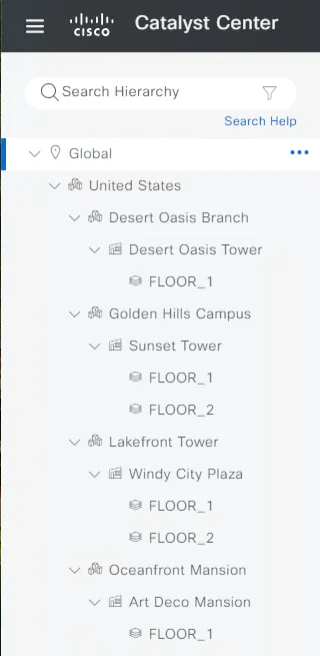
Go to Design > Network Settings > IP Address Pools
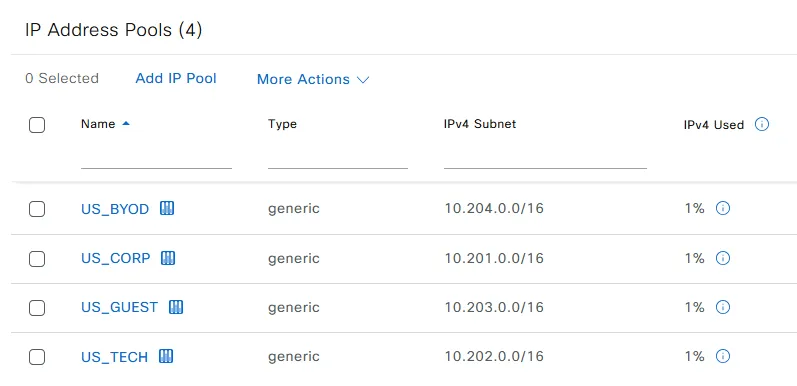
Step 4: Adding additional resources
Section titled “Step 4: Adding additional resources”Now that the sites and IP Pools are deployed, it becomes easy to add additional resources to Sites. Add a new Floor definition to Art Deco Mansion building (Global/United States/Oceanfront Mansion/Art Deco Mansion) by adding the following lines to the floors section in sites.nac.yaml:
- name: FLOOR_2 floor_number: 2 height: 4 parent_name: Global/United States/Oceanfront Mansion/Art Deco MansionThe sites.nac.yaml file with the new floor should look like this:
sites.nac.yaml
---catalyst_center: sites: areas: - name: United States parent_name: Global - name: Golden Hills Campus parent_name: Global/United States - name: Lakefront Tower parent_name: Global/United States - name: Oceanfront Mansion parent_name: Global/United States - name: Desert Oasis Branch parent_name: Global/United States buildings: - name: Sunset Tower latitude: 34.099 longitude: -118.366 address: 8358 Sunset Blvd, Los Angeles, CA 90069 country: United States parent_name: Global/United States/Golden Hills Campus ip_pools_reservations: - ST_CORP - ST_TECH - ST_GUEST - ST_BYOD - name: Windy City Plaza latitude: 41.878 longitude: -87.630 address: 233 S Wacker Dr, Chicago, IL 60606 country: United States parent_name: Global/United States/Lakefront Tower ip_pools_reservations: - WCP_CORP - WCP_TECH - WCP_GUEST - WCP_BYOD - name: Art Deco Mansion latitude: 25.782 longitude: -80.133 address: 123 Ocean Drive, Miami Beach, FL 33139 country: United States parent_name: Global/United States/Oceanfront Mansion ip_pools_reservations: - ADM_CORP - ADM_TECH - ADM_GUEST - ADM_BYOD - name: Desert Oasis Tower latitude: 33.448 longitude: -112.074 address: 1235 Cactus Ave, Phoenix, AZ 85001 country: United States parent_name: Global/United States/Desert Oasis Branch ip_pools_reservations: - DOT_CORP - DOT_TECH - DOT_GUEST - DOT_BYOD floors: - name: FLOOR_1 floor_number: 1 parent_name: Global/United States/Golden Hills Campus/Sunset Tower - name: FLOOR_2 floor_number: 2 parent_name: Global/United States/Golden Hills Campus/Sunset Tower - name: FLOOR_1 floor_number: 1 parent_name: Global/United States/Lakefront Tower/Windy City Plaza - name: FLOOR_2 floor_number: 2 parent_name: Global/United States/Lakefront Tower/Windy City Plaza - name: FLOOR_1 floor_number: 1 parent_name: Global/United States/Oceanfront Mansion/Art Deco Mansion - name: FLOOR_1 floor_number: 1 parent_name: Global/United States/Desert Oasis Branch/Desert Oasis Tower - name: FLOOR_2 floor_number: 2 height: 4 parent_name: Global/United States/Oceanfront Mansion/Art Deco MansionSave the file (Ctrl + S) and run terraform apply
terraform applyFollowed by yes to approve.
Terraform will compare the state file with the new plan and calculate any resources that need to be added, changed or destroyed. In this case, one new resource will be created. Terraform will create a new floor under Art Deco Mansion building while the existing resources will not be impacted, meaning if you re-execute the existing configuration stays as it is.
Apply complete! Resources: 1 added, 0 changed, 0 destroyed.Navigate to Catalyst Center (Design > Network Hierarchy) and verify that the new floor FLOOR_2 under Art Deco Mansion was added.
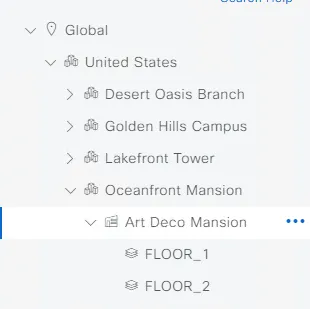
Step 5: Removing resources
Section titled “Step 5: Removing resources”In this step you will remove floor FLOOR_2 from Art Deco Mansion, which was created in step 4.
Remove the floor FLOOR_2 section from sites.nac.yaml
- name: FLOOR_2 floor_number: 2 height: 4 parent_name: Global/United States/Oceanfront Mansion/Art Deco MansionThe sites.nac.yaml file should once again look like this:
---catalyst_center: sites: areas: - name: United States parent_name: Global - name: Golden Hills Campus parent_name: Global/United States - name: Lakefront Tower parent_name: Global/United States - name: Oceanfront Mansion parent_name: Global/United States - name: Desert Oasis Branch parent_name: Global/United States buildings: - name: Sunset Tower latitude: 34.099 longitude: -118.366 address: 8358 Sunset Blvd, Los Angeles, CA 90069 country: United States parent_name: Global/United States/Golden Hills Campus ip_pools_reservations: - ST_CORP - ST_TECH - ST_GUEST - ST_BYOD - name: Windy City Plaza latitude: 41.878 longitude: -87.630 address: 233 S Wacker Dr, Chicago, IL 60606 country: United States parent_name: Global/United States/Lakefront Tower ip_pools_reservations: - WCP_CORP - WCP_TECH - WCP_GUEST - WCP_BYOD - name: Art Deco Mansion latitude: 25.782 longitude: -80.133 address: 123 Ocean Drive, Miami Beach, FL 33139 country: United States parent_name: Global/United States/Oceanfront Mansion ip_pools_reservations: - ADM_CORP - ADM_TECH - ADM_GUEST - ADM_BYOD - name: Desert Oasis Tower latitude: 33.448 longitude: -112.074 address: 1235 Cactus Ave, Phoenix, AZ 85001 country: United States parent_name: Global/United States/Desert Oasis Branch ip_pools_reservations: - DOT_CORP - DOT_TECH - DOT_GUEST - DOT_BYOD floors: - name: FLOOR_1 floor_number: 1 parent_name: Global/United States/Golden Hills Campus/Sunset Tower - name: FLOOR_2 floor_number: 2 parent_name: Global/United States/Golden Hills Campus/Sunset Tower - name: FLOOR_1 floor_number: 1 parent_name: Global/United States/Lakefront Tower/Windy City Plaza - name: FLOOR_2 floor_number: 2 parent_name: Global/United States/Lakefront Tower/Windy City Plaza - name: FLOOR_1 floor_number: 1 parent_name: Global/United States/Oceanfront Mansion/Art Deco Mansion - name: FLOOR_1 floor_number: 1 parent_name: Global/United States/Desert Oasis Branch/Desert Oasis TowerSave the file (Ctrl + S) and run terraform apply:
terraform applyFollowed by yes to approve.
Terraform will compare the state file with the new plan and calculate any resources that need to be added, changed or destroyed. In this case, one resource will be destroyed.
Apply complete! Resources: 0 added, 0 changed, 1 destroyed.Navigate to the Catalyst Center and verify that the floor FLOOR_2 has been removed from the building Art Deco Mansion
Step 6: Making changes
Section titled “Step 6: Making changes”You have now added and removed resources, but what if you want to deploy additional configuration settings? For example, how would you change floor length on a Floor? Which attributes can you use, and what values are expected? This is where the Datamodel Docs come in. Following the structure of the six different configuration areas, this section contains a list of all the resources that are currently supported. Under each resource you can find a list of attributes, their type, any constraints, whether they are required and whether they have a default value. It also includes a concise example of how that resource can be configured.
If you go to Sites > Floor, you’ll notice that the length attribute is an integer, as described here. This attribute is optional for this resource and does not have a default value. To modify this setting for a floor, you must explicitly specify this attribute.
Update the sites.nac.yaml file by adding the line length: 20 under floor FLOOR_1 in the building Art Deco Mansion.
length: 20The section for FLOOR_1 should look like this:
- name: FLOOR_1 floor_number: 1 parent_name: Global/United States/Oceanfront Mansion/Art Deco Mansion length: 20Save the file (Ctrl + S) and run terraform apply:
terraform applyFollowed by yes to approve.
Terraform will compare the existing state file with the new plan and calculate any resources that need to be added, changed or destroyed. In this case, one resource will be changed. The resource will be updated in-place.
Apply complete! Resources: 0 added, 1 changed, 0 destroyed.This will update the existing Floor with the new setting for length. Navigate to the Catalyst Center and verify that the floor FLOOR_1 under Art Deco Mansion building was updated with the new length configuration.
Go to Design > Network Hierarchy > Global > United States > Oceanfront Mansion > Art Deco Mansion > FLOOR_1. Click on ... and select View Details
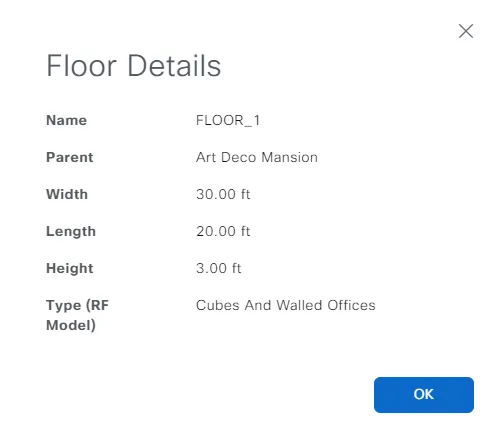
Step 7: Working with default values
Section titled “Step 7: Working with default values”The previous step explained how to modify a setting on a single resource. If you have specific configuration you wish to apply to each instance of that resource you can leverage a defaults.yaml file. The main.tf plan passes the content of defaults.yaml to the module. This allows a user to modify any default settings to reflect their requirements.
Create defaults.yaml file inside data/ folder with following content:
---defaults: catalyst_center: sites: floors: length: 20The defaults.yaml file follows the same structure as the other yaml files in the inventory.
Save the file (Ctrl + S) and run terraform apply:
terraform applyFollowed by yes to approve.
The output will show that the terraform apply action will update floors with new length.

Run terraform apply followed by yes to approve.
Step 8: Changing configuration in the GUI
Section titled “Step 8: Changing configuration in the GUI”Imagine that someone unaware of the automation efforts makes a change directly in the GUI to one of the objects created by Terraform.
Change floor height to 4ft on FLOOR_1 in Desert Oasis Tower building via the GUI.
Go to Design > Network Hierarchy > Global > United States > Desert Oasis Branch > Desert Oasis Tower > FLOOR_1. Click on ... and select Edit Floor

Because the Terraform state now differs from the running configuration a simple terraform apply will prompt you to update floor. Terraform can detect configuration drift and reconcile it.
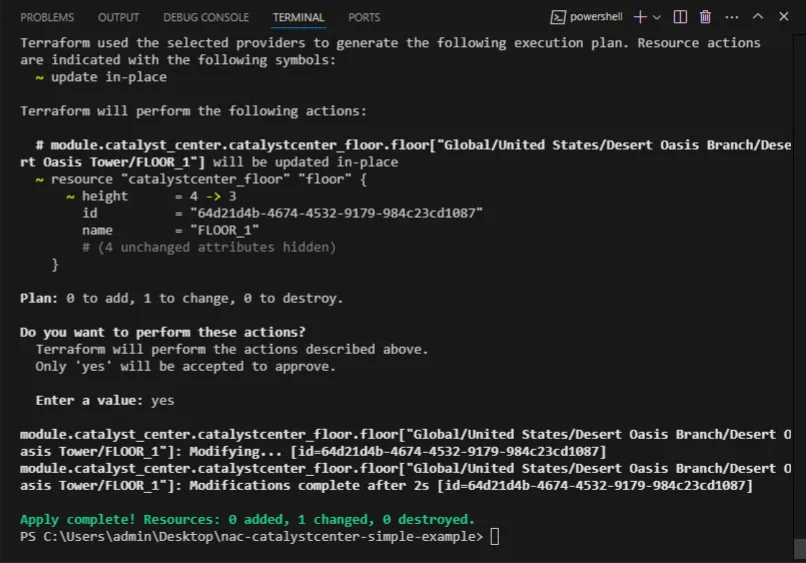
Step 9: Cleaning up
Section titled “Step 9: Cleaning up”The final step is to clean up the configuration.
Run terraform destroy to remove the configuration:
terraform destroyFollowed by yes to approve.
Apply complete! Resources: 0 added, 0 changed, 36 destroyed.Navigate to Catalyst Center and ensure that IP Pools and Site Hierarchy have been removed.